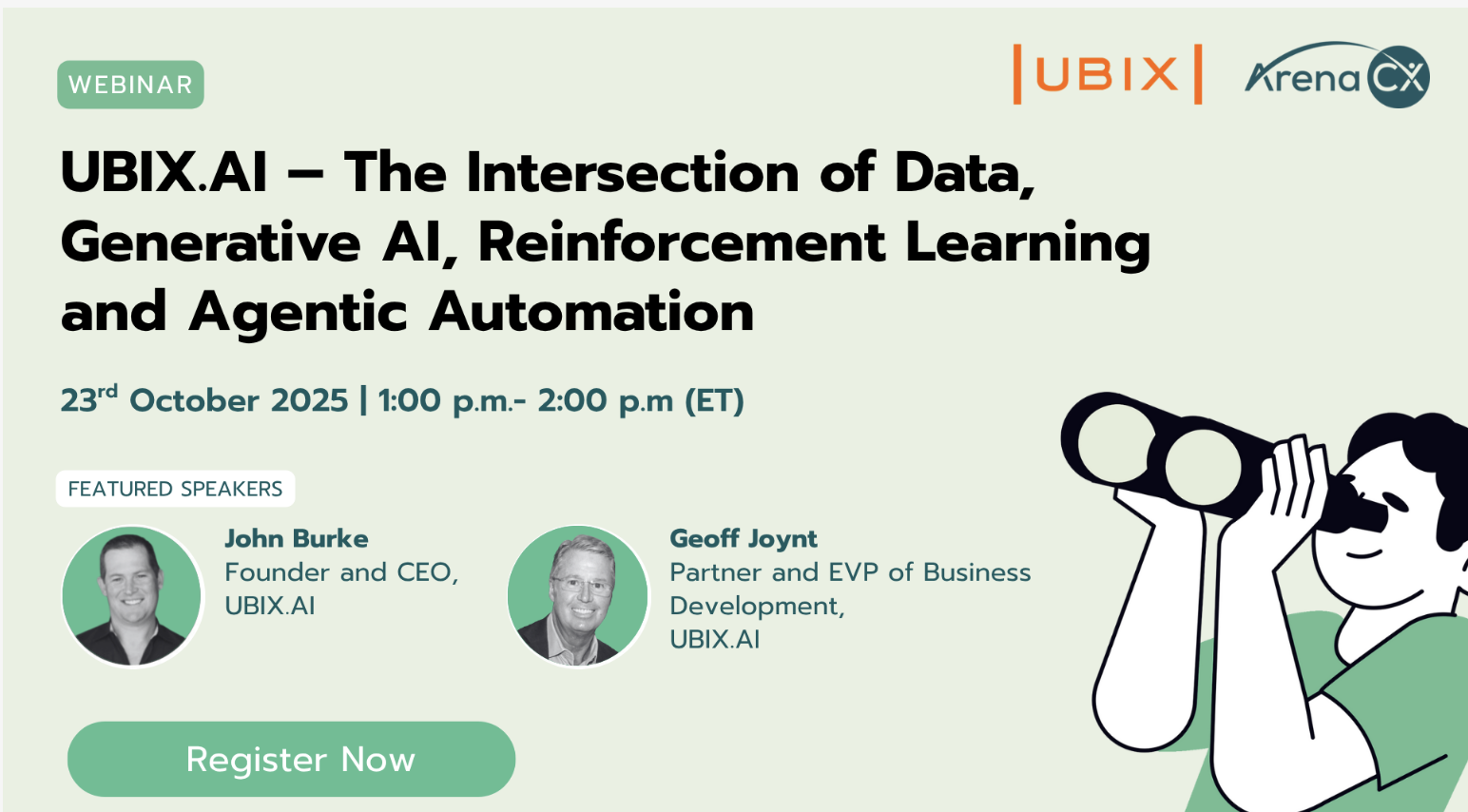AgenticAI – What is an Autonomous Decision Agent and Why Should You Care?
There is a huge buzz in the market right now on the value of AgenticAI, which marks a new era of enterprise intelligent automation that shifts from...
Where Everyone can Leverage AI to Empower their Business.
Learn More
Features
Unleashing Insights through Conversational Interactions
Centrally Manage all Enterprise Data for Analytics and Artificial Intelligence
Author Analytic Solutions for specific classes of Business Challenges
Interact with Business Applications & Real-Time Insights
Deploy & Manage Applications & AI Production Models
Manage Cloud Instances Across the Cloud & AI Lifecycle
Where everyone can leverage AI to empower their business.
Driving the future of Data Intelligence.
If your technology providers aren't held to this standard, everyone loses...
Industries Cont'd
UBIX is the leader in Cloud-Based AI for Everyday Businesses.
Learn how UBIX is changing the way Organizations use AI.
Your resource for everything AI and Data Science made easy. We'll take you from beginner to citizen data scientist in record time.
Learn how UBIX has made AI available to Everyone, especially those in business environments with minimal technical training.
Your destination for information on new innovation, news about UBIX, and featured articles on remarkable companies doing amazing things with AI.
Learn how UBIX is unifying Data Silos and Consolidating core systems for businesses around the world.
Time to geek-out. Dig in here for info on how UBIX is currently being used to solve problems and transform businesses.
Learn how UBIX has made Cloud-based AI quick and easy to deploy, allowing you access to world-class tech same-day with minimal effort.
Where everyone can visualize the feature and predict step.
Where everyone can visualize the feature and predict step.
In part 1 of this series on The Agent-Driven Enterprise, we introduced how Agentic AI moves beyond predictive analytics to create autonomous digital teammates that sense, reason, and act within business guardrails. Now we will take a deeper dive into the promise versus reality as well as how the industry analysts look at this emerging market.
Think of Agentic AI agents not as simple tools, but as trusted colleagues who embed themselves into the enterprise fabric. Rather than existing as detached applications, they integrate seamlessly into the enterprise stack and operate in tandem with human teams across various functions. This integration transforms how organizations perceive intelligence: agents are not external utilities but active, collaborative partners that help shoulder complex operational responsibilities within a framework of security, governance and compliance.
These agents can unify data dispersed across silos, not just from within the enterprise but also publicly available data sources, offering a clear and integrated view of operations that executives can act on. They excel at detecting anomalies, whether subtle fraud indicators, early risk signals, or signs of customer churn. Their ability to run thousands of simulations instantly allows businesses to test multiple scenarios before allocating resources—something that would otherwise be impossible at human speed or scale.
Furthermore, Agentic AI agents suggest optimized actions in natural language, removing the need for executives to interpret complex technical output. They can also safely carry out routine or delegated tasks within established business guardrails, ensuring compliance and governance are maintained. This makes them not just decision-support tools but operational teammates.
Executives stay involved—setting vision, shaping strategy, and approving key actions—while agents manage daily operational intelligence. This balance allows leaders to concentrate on strategic growth while trusting their digital team to monitor, adapt, and act precisely in real time.
Analytics historically and notoriously requires costly technical expertise, often involving specialized teams of data scientists, statisticians, and engineers to handle modeling, testing, and visualization. This process requires a lot of time and resources, slowing down how quickly insights reach executives. Agentic AI reduces this barrier by automating much of the work, turning what once took weeks into real-time outputs that business leaders can act on immediately.
With Agentic AI, the benefits are wide-ranging. Automated modeling and correlation testing help systems identify important patterns and variables without manual input. Natural language interaction allows executives and managers to simply ask questions and get contextual, plain-language responses. Opportunities for optimization go beyond individual functions—they span finance, supply chain, sales, and operations, ensuring decisions are made with a complete view of enterprise dynamics.
Consider the example of a global retailer. This company uses Agentic AI to monitor logistics and predict potential disruptions. When a port strike is imminent, the agents forecast downstream effects on distribution centers and retail stores. They then suggest rerouting options, negotiate freight capacity with logistics providers, and present a clear, concise risk-mitigation plan to executives. Instead of reacting only after delays start affecting revenue, the company stays ahead of the disruption—preventing empty shelves, maintaining customer satisfaction, saving millions of dollars, and safeguarding its brand reputation. This demonstrates how Agentic AI turns complexity into clarity and creates a proactive advantage.
Beyond GenAI-Only Agents: UBIX Unifies GenAI + Machine Learning (ML) for True Enterprise AI
|
Traditional AI / ML Agents |
UBIX Self-service Agentic AI |
|
Predominantly LLM-based assistants (chatbots, copilots) with limited ML integration |
Supports both LLM-based and ML-based agents — from assistant agents to autonomous decision robots |
|
Reliance on scarce data science & IT resources |
Self-service AI empowers business users and domain experts directly |
|
Long, costly projects (months/years to production) |
Rapid innovation: prototypes in days, production in weeks |
|
Siloed pilots with limited adoption |
Enterprise-ready: scalable across functions and industries |
|
Heavy coding, DevOps, and infra complexity |
100% no-code, turnkey SaaS with infra-as-code automation |
|
Static models, slow iteration |
Continuous learning through reusable ML/AI patterns and RL agents |
Agentic AI is industry-agnostic but adapts to specific verticals. Its flexibility means that while the core technology stays consistent, the outcomes and applications change to meet each industry's needs. In every vertical market, there are a set of current and desired use cases where Agentic AI can deliver immediate ROI. Start by considering uses cases to reduce operational costs with AI, then evaluate use cases to expand existing processes for cost effective scale with AI and then you are ready for use cases to establish new products/markets with AI.
Industry analysts consistently highlight Agentic AI as the next major leap in enterprise intelligence. They emphasize that this shift is not gradual but disruptive, transforming how organizations make decisions, execute strategies, and compete in fast-changing markets. Reports from Gartner, Forrester, and McKinsey focus on several key themes:
According to industry analyst Gartner Group “By 2028, 33% of enterprise software applications will include Agentic AI, up from less than 1% in 2024, enabling 15% of day-to-day work decisions to be made autonomously.”
Imagine 15% of day-to-day decisions being made autonomously and the impact to productivity and profitability that will provide, and you have a primary reason to dig deeper into the value of Agentic AI for your organization.
Analysts also caution that while the opportunities are immense, the winners will be those that establish early proof points, build robust governance frameworks, and link Agentic AI directly to measurable business outcomes such as revenue growth, cost savings, and risk mitigation.

There is a huge buzz in the market right now on the value of AgenticAI, which marks a new era of enterprise intelligent automation that shifts from...

Discover how Agentic AI is transforming real-world outcomes.AI transformation is no longer about future potential — it’s about measurable impact...

In part 1 of this series on The Agent-Driven Enterprise, we introduced how Agentic AI moves beyond predictive analytics to create autonomous digital...
